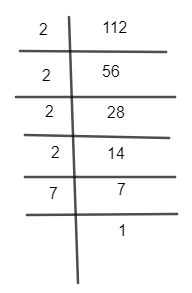
Two finite sets have m and n elements. The number of subsets of the first set is 112 more than of the second set. The values of m and n respectively are
A. 4, 7
B. 7, 4
C. 4, 4
D. 7, 7
Answer
606k+ views
Hint: The number of subsets of m, n elements will be ${{2}^{m}},{{2}^{n}}$ respectively so it can be written as ${{2}^{m}}-{{2}^{n}}=112$. After that factorize 112 to separate factors of 2 and then equate the equation to get the desired result.
Complete step-by-step solution:
We are given two finite sets with m and n elements. If the number of elements is ‘l’ then the number of subsets are ${{2}^{l}}$.
Just for an example consider a set like {1,2,3} then its subsets are {1},{2},{3},{1,2},{1,3},{2,3},{1,2,3},{}.
Hence the numbers of elements were 3 and its number of subsets is ${{2}^{3}}=8$ which is given.
So if the elements of a set are m and n so the number of subsets are ${{2}^{m}}$ and ${{2}^{n}}$ respectively.
In the question we are given that the numbers of subsets with m elements are 112 more than the number of subsets with n elements.
So we can write as,
${{2}^{m}}-{{2}^{n}}=112\ldots \ldots (1)$
We can take ${{2}^{n}}$ common in left hand side of (1) we get,
${{2}^{n}}({{2}^{m-n}}-1)=112\ldots \ldots (2)$
Now let’s analyse the left hand side of (1) we can see that it’s a product of an even and an odd number. The even number will have only 2 as its prime factor so we can factorize 112 as,

So 112 can be written as ${{2}^{4}}\times 7.$
Now we will substitute it in equation (2) so we get,
${{2}^{n}}\left( {{2}^{m-n}}-1 \right)={{2}^{4}}\times 7\ldots \ldots (3)$
No, $\left( {{2}^{m-n}}-1 \right)$can never be equal to ${{2}^{4}}$ as one is odd and other is even.
So,
${{2}^{n}}={{2}^{4}}$
Now we can apply law which is when bases are equal exponents are the same.
So the value of n=4.
Now we will put n=4 in equation (3) we get,
${{2}^{4}}\left( {{2}^{m-4}}-1 \right)={{2}^{4}}\times 7$
which can be further represented as,
${{2}^{m-4}}-1=7\ldots \ldots (4)$
Now adding 1 in both the sides of equation (4) we get,
${{2}^{m-4}}=8$
Now we can represent 8 as \[{{2}^{3}}\] to make the bases equal so it can be further written as,
${{2}^{m-4}}={{2}^{3}}$
Applying law of indices which bases are same exponents are equal we get,
m-4 = 3
So, the value of m=7.
Hence the answer is B.
Note: In this question one can tell answer without even solving it as we know that the subsets of m elements are greater than that of n elements then m and n cannot be equal so option C, D cancels out and m should always be greater than n so option A. also cancels B. is the answer.
Complete step-by-step solution:
We are given two finite sets with m and n elements. If the number of elements is ‘l’ then the number of subsets are ${{2}^{l}}$.
Just for an example consider a set like {1,2,3} then its subsets are {1},{2},{3},{1,2},{1,3},{2,3},{1,2,3},{}.
Hence the numbers of elements were 3 and its number of subsets is ${{2}^{3}}=8$ which is given.
So if the elements of a set are m and n so the number of subsets are ${{2}^{m}}$ and ${{2}^{n}}$ respectively.
In the question we are given that the numbers of subsets with m elements are 112 more than the number of subsets with n elements.
So we can write as,
${{2}^{m}}-{{2}^{n}}=112\ldots \ldots (1)$
We can take ${{2}^{n}}$ common in left hand side of (1) we get,
${{2}^{n}}({{2}^{m-n}}-1)=112\ldots \ldots (2)$
Now let’s analyse the left hand side of (1) we can see that it’s a product of an even and an odd number. The even number will have only 2 as its prime factor so we can factorize 112 as,

So 112 can be written as ${{2}^{4}}\times 7.$
Now we will substitute it in equation (2) so we get,
${{2}^{n}}\left( {{2}^{m-n}}-1 \right)={{2}^{4}}\times 7\ldots \ldots (3)$
No, $\left( {{2}^{m-n}}-1 \right)$can never be equal to ${{2}^{4}}$ as one is odd and other is even.
So,
${{2}^{n}}={{2}^{4}}$
Now we can apply law which is when bases are equal exponents are the same.
So the value of n=4.
Now we will put n=4 in equation (3) we get,
${{2}^{4}}\left( {{2}^{m-4}}-1 \right)={{2}^{4}}\times 7$
which can be further represented as,
${{2}^{m-4}}-1=7\ldots \ldots (4)$
Now adding 1 in both the sides of equation (4) we get,
${{2}^{m-4}}=8$
Now we can represent 8 as \[{{2}^{3}}\] to make the bases equal so it can be further written as,
${{2}^{m-4}}={{2}^{3}}$
Applying law of indices which bases are same exponents are equal we get,
m-4 = 3
So, the value of m=7.
Hence the answer is B.
Note: In this question one can tell answer without even solving it as we know that the subsets of m elements are greater than that of n elements then m and n cannot be equal so option C, D cancels out and m should always be greater than n so option A. also cancels B. is the answer.
Recently Updated Pages
Master Class 11 Business Studies: Engaging Questions & Answers for Success

Master Class 11 Computer Science: Engaging Questions & Answers for Success

Master Class 11 Maths: Engaging Questions & Answers for Success

Master Class 11 Chemistry: Engaging Questions & Answers for Success

Master Class 11 Economics: Engaging Questions & Answers for Success

Master Class 11 Accountancy: Engaging Questions & Answers for Success

Trending doubts
What is meant by exothermic and endothermic reactions class 11 chemistry CBSE

10 examples of friction in our daily life

One Metric ton is equal to kg A 10000 B 1000 C 100 class 11 physics CBSE

1 Quintal is equal to a 110 kg b 10 kg c 100kg d 1000 class 11 physics CBSE

Difference Between Prokaryotic Cells and Eukaryotic Cells

What are Quantum numbers Explain the quantum number class 11 chemistry CBSE




